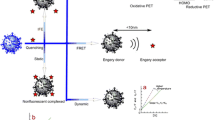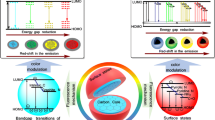Abstract
We demonstrate the fabrication of a new DNA sensor that is based on the optical interactions occurring between oligonucleotide-coated NaYF4:Yb3+;Er3+ upconversion nanoparticles and the two-dimensional dichalcogenide materials, MoS2 and WS2. Monodisperse upconversion nanoparticles were functionalized with single-stranded DNA endowing the nanoparticles with the ability to interact with the surface of the two-dimensional materials via van der Waals interactions leading to subsequent quenching of the upconversion fluorescence. By contrast, in the presence of a complementary oligonucleotide target and the formation of double-stranded DNA, the upconversion nanoparticles could not interact with MoS2 and WS2, thus retaining their inherent fluorescence properties. Utilizing this sensor we were able to detect target oligonucleotides with high sensitivity and specificity whilst reaching a concentration detection limit as low as 5 mol·L−1, within minutes.

Article PDF
Similar content being viewed by others
References
Wang J. DNA biosensors based on peptide nucleic acid (PNA) recognition layers. A review. Biosensors & Bioelectronics, 1998, 13 (7–8): 757–762
Leatherbarrow R J, Edwards P R. Analysis of molecular recognition using optical biosensors. Current Opinion in Chemical Biology, 1999, 3(5): 544–547
Akyilmaz E, Yorganci E, Asav E. Do copper ions activate tyrosinase enzyme? A biosensor model for the solution. Bioelectrochemistry, 2010, 78(2): 155–160
Soraya G V, Chan J X, Nguyen T C, Huynh D H, Abeyrathne C D, Chana G, Todaro M, Skafidas E, Kwan P. An interdigitated electrode biosensor platform for rapid HLA-B*15:02 genotyping for prevention of drug hypersensitivity. Biosensors & Bioelectronics, 2018, 111: 174–183
Contag C H, Bachmann M H. Advances in in vivo bioluminescence imaging of gene expression. Annual Review of Biomedical Engineering, 2002, 4(1): 235–260
Heuer Jungemann A, El Sagheer A H, Lackie P M, Brown T, Kanaras A G. Selective killing of cells triggered by their mRNA signature in the presence of smart nanoparticles. Nanoscale, 2016, 8 (38): 16857–16861
Halo T L, McMahon K M, Angeloni N L, Xu Y, Wang W, Chinen A B, Malin D, Strekalova E, Cryns V L, Cheng C, et al. NanoFlares for the detection, isolation, and culture of live tumor cells from human blood. Proceeding of the National Academy of Sciences of the United States of America, 2014, 111(48): 17104–17109
Mobed A, Hasanzadeh M, Ahmadalipour A, Fakhari A. Recent advances in the biosensing of neurotransmitters: material and method overviews towards the biomedical analysis of psychiatric disorders. Analytical Methods, 2020, 12(4): 557–575
Blair E O, Corrigan D K. A review of microfabricated electrochemical biosensors for DNA detection. Biosensors & Bioelectronics, 2019, 134: 57–67
Mehrvar M, Abdi M. Recent developments, characteristics, and potential applications of electrochemical biosensors. Analytical Sciences, 2004, 20(8): 1113–1126
Matharu Z, Daggumati P, Wang L, Dorofeeva T S, Li Z D, Seker E. Nanoporous-gold-based electrode morphology libraries for investigating structure-property relationships in nucleic acid based electrochemical biosensors. ACS Applied Materials & Interfaces, 2017, 9(15): 12959–12966
Garcia T, Revenga Parraa M, Anorga L, Arana S, Pariente F, Lorenzo E. Disposable DNA biosensor based on thin-film gold electrodes for selective Salmonella detection. Sensors and Actuators. B, Chemical, 2012, 161(1): 1030–1037
Lange K, Rapp B E, Rapp M. Surface acoustic wave biosensors: a review. Analytical and Bioanalytical Chemistry, 2008, 391(5): 1509–1519
Ten S T, Hashim U, Gopinath S C B, Liu W W, Foo K L, Sam S T, Rahman S F A, Voon C H, Nordin A N. Highly sensitive Escherichia coli shear horizontal surface acoustic wave biosensor with silicon dioxide nanostructures. Biosensors & Bioelectronics, 2017, 93: 146–154
Zhang Y L, Yang F, Sun Z Y, Li Y T, Zhang G J. A surface acoustic wave biosensor synergizing DNA-mediated in situ silver nanoparticle growth for a highly specific and signal-amplified nucleic acid assay. Analyst (London), 2017, 142(18): 3468–3476
Afzal A, Mujahid A, Schirhagl R, Bajwa S Z, Latif U, Feroz S. Gravimetric viral diagnostics: QCM based biosensors for early detection of viruses. Chemosensors, 2017, 5(1): 7
Damborsky P, Svitel J, Katrlik J. Optical biosensors. Essays in Biochemistry, 2016, 60(1): 91–100
Dey D, Goswami T. Optical biosensors: a revolution towards quantum nanoscale electronics device fabrication. Journal of Biomedicine & Biotechnology, 2011, 10(5204): 348218
Shin Y, Perera A P, Park M K. Label-free DNA sensor for detection of bladder cancer biomarkers in urine. Sensors and Actuators. B, Chemical, 2013, 178: 200–206
Petty J T, Story S P, Hsiang J C, Dickson R M. DNA-templated molecular silver fluorophores. Journal of Physical Chemistry Letters, 2013, 4(7): 1148–1155
Nguyen H H, Park J, Kang S, Kim M. Surface plasmon resonance: a versatile technique for biosensor applications. Sensors (Basel), 2015, 15(5): 10481–10510
Patil P O, Pandey G R, Patil A G, Borse V B, Deshmukh P K, Patil D R, Tade R S, Nangare S N, Khan Z G, Patil A M, et al. Graphene-based nanocomposites for sensitivity enhancement of surface plasmon resonance sensor for biological and chemical sensing: a review. Biosensors & Bioelectronics, 2019, 139: 111324
Shi J Y, Tian F, Lyu J, Yang M. Nanoparticle based fluorescence resonance energy transfer (FRET) for biosensing applications. Journal of Materials Chemistry. B, Materials for Biology and Medicine, 2015, 3(35): 6989–7005
Schuster J, Brabandt J, Von Borczyskowski C. Discrimination of photoblinking and photobleaching on the single molecule level. Journal of Luminescence, 2007, 127(1): 224–229
Frangioni J V. In vivo near-infrared fluorescence imaging. Current Opinion in Chemical Biology, 2003, 7(5): 626–634
Smith A M, Mancini M C, Nie S M. Bioimaging second window for in vivo imaging. Nature Nanotechnology, 2009, 4(11): 710–711
Binnemans K. Lanthanide-based luminescent hybrid materials. Chemical Reviews, 2009, 109(9): 4283–4374
Wang X, Valiev R R, Ohulchanskyy T Y, Agren H, Yang C, Chen G. Dye-sensitized lanthanide-doped upconversion nanoparticles. Chemical Society Reviews, 2017, 46(14): 4150–4167
Wang Y F, Liu G Y, Sun L D, Xiao J W, Zhou J C, Yan C H. Nd3+-sensitized upconversion nanophosphors: efficient in vivo bioimaging probes with minimized heating effect. ACS Nano, 2013, 7(8): 7200–7206
Liu J, Liu Y, Bu W, Bu J, Sun Y, Du J, Shi J. Ultrasensitive nanosensors based on upconversion nanoparticles for selective hypoxia imaging in vivo upon near-infrared excitation. Journal of the American Chemical Society, 2014, 136(27): 9701–9709
Chen Z, Chen H, Hu H, Yu M, Li F, Zhang Q, Zhou Z, Yi T, Huang C. Versatile synthesis strategy for carboxylic acid-functionalized upconverting nanophosphors as biological labels. Journal of the American Chemical Society, 2008, 130(10): 3023–3029
Huang Y X, Shi Y M, Yang H Y, Ai Y. A novel single-layered MoS2 nanosheet based microfluidic biosensor for ultrasensitive detection of DNA. Nanoscale, 2015, 7(6): 2245–2249
Wu M, Kempaiah R, Huang P J J, Maheshwari V, Liu J W. Adsorption and desorption of DNA on graphene oxide studied by fluorescently labeled oligonucleotides. Langmuir, 2011, 27(6): 2731–2738
Alonso Cristobal P, Vilela P, El Sagheer A, Lopez Cabarcos E, Brown T, Muskens O L, Rubio Retama J, Kanaras A G. Highly sensitive DNA sensor based on upconversion nanoparticles and graphene oxide. ACS Applied Materials & Interfaces, 2015, 7(23): 12422–12429
Vilela P, El Sagheer A, Millar T M, Brown T, Muskens O L, Kanaras A G. Graphene oxide-upconversion nanoparticle based optical sensors for targeted detection of mRNA biomarkers present in Alzheimer’s disease and prostate cancer. ACS Sensors, 2017, 2 (1): 52–56
Giust D, Lucio M I, El Sagheer A H, Brown T, Williams L E, Muskens O L, Kanaras A G. Graphene oxide-upconversion nanoparticle based portable sensors for assessing nutritional deficiencies in crops. ACS Nano, 2018, 12(6): 6273–6279
Huang L J, Tian X, Yi J T, Yu R Q, Chu X. A turn-on upconversion fluorescence resonance energy transfer biosensor for ultrasensitive endonuclease detection. Analytical Methods, 2015, 7(18): 7474–7479
Wang F F, Qu X T, Liu D X, Ding C P, Zhang C L, Xian Y Z. Upconversion nanoparticles-MoS2 nanoassembly as a fluorescent turn-on probe for bioimaging of reactive oxygen species in living cells and zebrafish. Sensors and Actuators. B, Chemical, 2018, 274: 180–187
Lu C, Liu Y B, Ying Y B, Liu J W. Comparison of MoS2,WS2, and graphene oxide for DNA adsorption and sensing. Langmuir, 2017, 33(2): 630–637
Kenry G A, Zhang X, Zhang H, Lim C T. Highly sensitive and selective aptamer-based fluorescence detection of a malarial biomarker using single-layer MoS2 nanosheets. ACS Sensors, 2016, 1(11): 1315–1321
Lv J J, Zhao S, Wu S J, Wang Z P. Upconversion nanoparticles grafted molybdenum disulfide nanosheets platform for microcystin-LR sensing. Biosensors & Bioelectronics, 2017, 90: 203–209
Yuan Y, Yu H, Yin Y. A highly sensitive aptasensor for vascular endothelial growth factor based on fluorescence resonance energy transfer from upconversion nanoparticles to MoS2 nanosheets. Analytical Methods: Advancing Methods and Applications, 2020, 12(36): 4466–4472
Li Z Q, Zhang Y. An efficient and user-friendly method for the synthesis of hexagonal-phase NaYF4:Yb, Er/Tm nanocrystals with controllable shape and upconversion fluorescence. Nanotechnology, 2008, 19(34): 345606
Wang F, Deng R R, Liu X G. Preparation of core-shell NaGdF4 nanoparticles doped with luminescent lanthanide ions to be used as upconversion-based probes. Nature Protocols, 2014, 9(7): 1634–1644
Lin W, Fritz K, Guerin G, Bardajee G R, Hinds S, Sukhovatkin V, Sargent E H, Scholes G D, Winnik M A. Highly luminescent lead sulfide nanocrystals in organic solvents and water through ligand exchange with poly(acrylic acid). Langmuir, 2008, 24(15): 8215–8219
Wang M, Abbineni G, Clevenger A, Mao C B, Xu S K. Upconversion nanoparticles: synthesis, surface modification and biological applications. Nanomedicine; Nanotechnology, Biology, and Medicine, 2011, 7(6): 710–729
Huang X Y, Lin J. Active-core/active-shell nanostructured design: an effective strategy to enhance Nd3+/Yb3+ cascade sensitized upconversion luminescence in lanthanide-doped nanoparticles. Journal of Materials Chemistry. C, Materials for Optical and Electronic Devices, 2015, 3(29): 7652–7657
Nie Z Y, Ke X X, Li D N, Zhao Y L, Zhu L L, Qiao R, Zhang X L. NaYF4:Yb,Er,Nd@NaYF4:Nd upconversion nanocrystals capped with Mn:TiO2 for 808 nm NIR-triggered photocatalytic applications. Journal of Physical Chemistry C, 2019, 123(37): 22959–22970
Neema P M, Tomy A M, Cyriac J. Chemical sensor platforms based on fluorescence resonance energy transfer (FRET) and 2D materials. Trac-Trends in Analytical Chemistry, 2020, 124: 115797
Hu Y L, Huang Y, Tan C L, Zhang X, Lu Q P, Sindoro M, Huang X, Huang W, Wang L H, Zhang H. Two-dimensional transition metal dichalcogenide nanomaterials for biosensing applications. Materials Chemistry Frontiers, 2017, 1(1): 24–36
Acknowledgements
Antonios G. Kanaras, Otto L. Muskens and Davide Giust would like to acknowledge funding from BBSRC (Grant No. BB/ N021150/1). Konstantina Alexaki would like to thank the University of Southampton for a Mayflower doctor of philosophy studentship.
Author information
Authors and Affiliations
Corresponding author
Supporting Information
Rights and permissions
Open Access This article is licensed under a Creative Commons Attribution 4.0 International License, which permits use, sharing, adaptation, distribution and reproduction in any medium or format, as long as you give appropriate credit to the original author(s) and the source, provide a link to the Creative Commons licence, and indicate if changes were made. The images or other third party material in this article are included in the article’s Creative Commons licence, unless indicated otherwise in a credit line to the material. If material is not included in the article’s Creative Commons licence and your intended use is not permitted by statutory regulation or exceeds the permitted use, you will need to obtain permission directly from the copyright holder. To view a copy of this licence, visit http://creativecommons.org/licenses/by/4.0/.
About this article
Cite this article
Alexaki, K., Giust, D., Kyriazi, ME. et al. A DNA sensor based on upconversion nanoparticles and two-dimensional dichalcogenide materials. Front. Chem. Sci. Eng. 15, 935–943 (2021). https://doi.org/10.1007/s11705-020-2023-9
Received:
Accepted:
Published:
Issue Date:
DOI: https://doi.org/10.1007/s11705-020-2023-9




